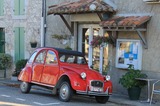
Unrestricted Use
CC BY
Students search for a French brand car to describe and then play a 20-questions style game with partners to guess and figure out what each other's selected cars look like.
- Subject:
- French
- Material Type:
- Activity/Lab
- Author:
- Ingrid McGuckin
- Date Added:
- 06/15/2021